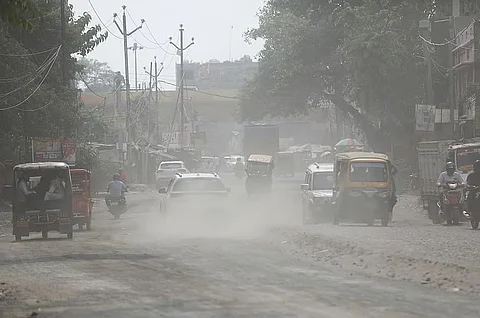

“When I came to Bhagalpur 30 years ago, there was neither so much noise nor so many vehicles here. In those days, hand rickshaws were mostly used for commuting,” Manoj Kumar Sharma, around 70 years old, reminisces to Down To Earth (DTE) while standing at Tilkamanjhi Chowk, one of the most popular and busy places in the Bihar city. It took him around 15 minutes to cross the road due to the fast speed and continuous movement of vehicles. While walking, he said, “Now everything is changing. Congestion is the marker of every city.”
There are traffic lights, but no one follows the rules. In Bhagalpur, people are habituated to honking their vehicle horns continuously. The elderly Sharma hears the loud blast and wryly remarks, “This is Bhagalpur’s gift.”
Bhagalpur, located on the southern bank of the Ganga, is Bihar’s third-largest city and also a commercial hub of the silk industry. It is also included in the 100 cities selected under the Smart City Mission. The city’s municipal corporation has formed the Bhagalpur Smart City Ltd (BSCL) to implement plans in this regard.
Efforts are on since 2015 to make Bhagalpur a ‘Smart City’. But they do not seem to be effective on the ground. Nor does the city have any comprehensive mobility plan of its own.
BSCL has conceded officially that pollution and traffic jams are the biggest obstacles to Bhagalpur becoming a Smart City.
DTE travelled across the city. Bhagalpur has a total road network of 175 kilometres, according to BSCL. But most of the roads are narrow, unpaved and encroached, with haphazard parking causing traffic jams. There are no footpaths for pedestrians.
Sanjeev Kumar, a senior journalist with the Hindi daily Prabhat Khabar, said encroachment is the main problem in Bhagalpur. “Not a single road is encroachment-free. People and vehicles have to pass through very narrow roads, due to which there is always gridlock.”
There is no bus system in Bhagalpur. Internal movement in the city is mainly by bicycle and auto rickshaws, with 6-seater diesel rickshaws being the most prominent and polluting mode of transport.
This was evident when DTE travelled Khalifabagh Chowk within the city, where there was a huge gathering of vehicles, despite the presence of traffic police. The same situation was seen at Kotwali Chowk and Ghantaghar.
One of the most important and busiest places in the city, Dixon More, is where private buses plying to other cities gather. Chunchun Kumar, a municipal corporation sanitation worker, while handling his cycle at this turn, said, “Sometimes it seems that we will meet with a major accident here. It is so crowded that one has to get off the cycle, control oneself and walk.”
Lohiya Path is full of private buses, cars and three-wheelers. According to Chunchun, this was not the situation earlier; in the past few years, the number of vehicles on the roads has increased rapidly.
According to the VAHAN Dashboard, the vehicle registration figures in Bhagalpur in the last five years (2020-2024) clearly indicate that the registration of private transport vehicles has been much higher than public transport. The most registered vehicle category was motorcycles/scooters, with a total number of 114,952. At the same time, the number of motor cars was 12,202 and the number of e-rickshaws was 14,927, which generally come under personal ownership.
On the other hand, the registration of public transport vehicles such as bus (193), motor cab (330), minibus/omni bus (7), and maxi cab (76) remained very slow during these five years. Overall, the registration number of these public transport vehicles was around 606, while the number of vehicles for private use crossed one lakh.
At the same time, the average growth rate of motorcycles/scooters on the basis of compound annual growth rate between 2020 and 2024 was about 7.2 per cent, while the growth rate of motor cars was about 6.5 per cent. The growth rate of e-rickshaws was more than this, about 25 per cent, which shows that there has been a rapid increase in the trend towards personally owned electric vehicles.
Bhagalpur also has a dust problem. National Highway 80, which connects the city to Sabour and is now a part of National Highway 33, is being widened. Consequently, there is only dust and big potholes all around. A professor at Bihar Agricultural University located in Sabour remarked that farmers are not able to participate in his programmes due to the bad condition of the road.
In the Bhagalpur Municipal Corporation area, which has a population of more than 400,000, people are forced to go out wearing masks in the morning and evening due to dust pollution.
All this means Bhagalpur is also among those Indian cities, other than megacities, that have the worst air quality. The study titled PM10 and PM2.5 in Indo Gangetic Plain (IGP) of India: Chemical Characterization, Source Analysis, and Transport Pathways, published in Science Direct, showed that Bhagalpur, despite being among smaller Indian cities, was more polluted than metros like Delhi and Kolkata.
To control the traffic snarl situation in Bhagalpur, an AI Integrated Command and Control Center (AIICCC) building has been established in May 2024 under the Smart City project. Traffic in the entire city is monitored from here via CCTV cameras installed at the intersections. Despite this, there is only dust and gridlock from the railway junction to the main intersections of the city.
This article is part of our series on how India moves, which looks at the relationship between air quality and human mobility in cities and towns.